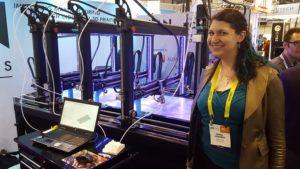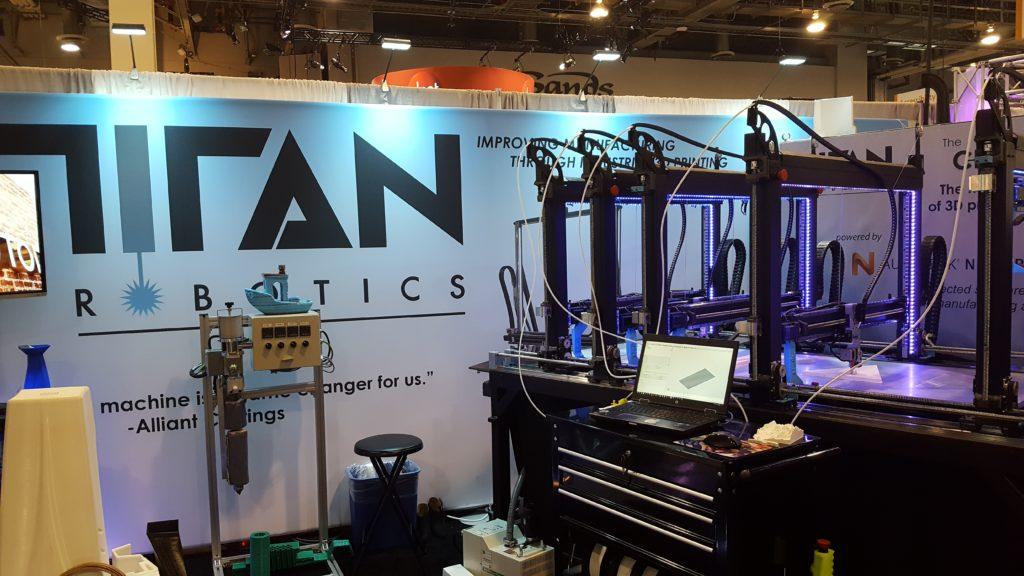Titan Robotics’ Large-Format 3D Printer, the Cronus, Features Five Print Heads and Autodesk Netfabb Software
 In 2016, 3D printer manufacturer Titan Robotics started work to build the first commercial multi-head machine featuring Autodesk’s Project Escher technology. Last week at CES 2017, the Colorado-based company was able to unveil the fruits of their labor: the impressive new multi-gantry Cronus 3D printer, featuring not one, not two, but five total print heads that come together to work on a single part at the same time.
In 2016, 3D printer manufacturer Titan Robotics started work to build the first commercial multi-head machine featuring Autodesk’s Project Escher technology. Last week at CES 2017, the Colorado-based company was able to unveil the fruits of their labor: the impressive new multi-gantry Cronus 3D printer, featuring not one, not two, but five total print heads that come together to work on a single part at the same time.
3DPrint.com was lucky enough to get a look at the groundbreaking new 3D printer in action on the show floor in Las Vegas, where it was officially introduced.
Titan Robotics founder and CEO Clay Guillory said, “At Titan Robotics, we know what it takes to make a truly industrial large-format 3D printer. This collaborative control technology is going to change everything we know about 3D printing and CNC manufacturing.”
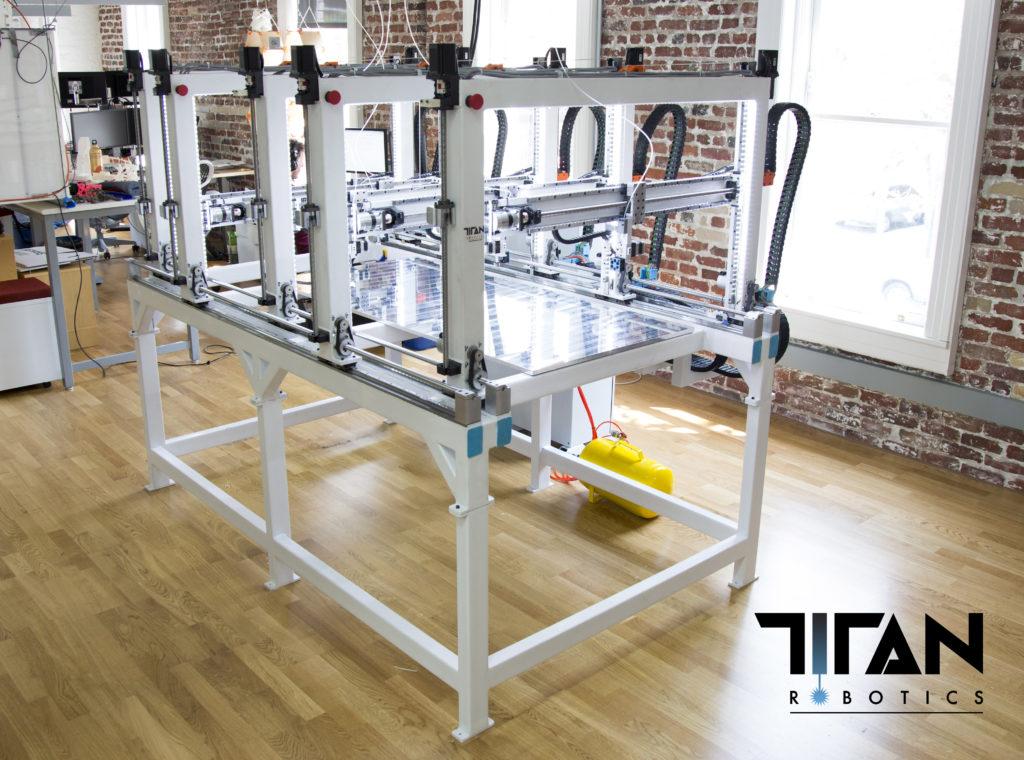 The original Project Escher, a parallel processing system, is now a part of the company’s additive manufacturing software, Autodesk Netfabb. The design software system “intelligently distributes tool paths between multiple print heads working in unison on a single printer.” It offers a wide variety of tools for build preparation, design optimization, and machine configuration, among others.
The original Project Escher, a parallel processing system, is now a part of the company’s additive manufacturing software, Autodesk Netfabb. The design software system “intelligently distributes tool paths between multiple print heads working in unison on a single printer.” It offers a wide variety of tools for build preparation, design optimization, and machine configuration, among others.
The FFF-style Cronus 3D printer, combined with the software’s collaborative multi-head printing technology, provides a cutting-edge solution for users in the additive manufacturing world. According to the website, it was designed and built with “premium quality electronics and precision components on all axes.” Its five print heads are capable of 3D printing industrial scale parts with greater detail and speed than traditional single-head 3D printing technology can.
Autodesk Principal Research scientist Andreas Bastian said, “It’s really exciting to upend what has traditionally been regarded as a desktop prototyping technology and show that it’s a powerful way to make large parts – such as molds and fixtures – out of high performance materials.”
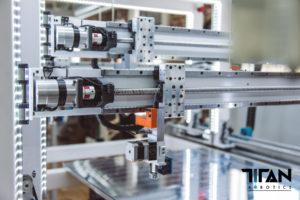 Titan Robotics knows that when you’re 3D printing on a large scale, the printer’s durability, precision, and rigidity are of the utmost importance to get a successful print. When developing the Cronus, the company utilized its innovative technology and proven concepts to decrease any issues with accuracy or detail when it came to 3D printing large, complex parts on the multi-head machine. The foundation of the Cronus is “a welded steel, precision machined frame fitted with the highest quality components, such as 16mm ballscrews, profiled linear rails and Yaskawa servo motors.” The printer’s multifaceted design means that it can be fitted with several different types of tool heads for both additive and subtractive manufacturing. One of these is the pellet extruder, which allows large parts to be fabricated extremely fast at 5 lbs/hour per print head.
Titan Robotics knows that when you’re 3D printing on a large scale, the printer’s durability, precision, and rigidity are of the utmost importance to get a successful print. When developing the Cronus, the company utilized its innovative technology and proven concepts to decrease any issues with accuracy or detail when it came to 3D printing large, complex parts on the multi-head machine. The foundation of the Cronus is “a welded steel, precision machined frame fitted with the highest quality components, such as 16mm ballscrews, profiled linear rails and Yaskawa servo motors.” The printer’s multifaceted design means that it can be fitted with several different types of tool heads for both additive and subtractive manufacturing. One of these is the pellet extruder, which allows large parts to be fabricated extremely fast at 5 lbs/hour per print head.
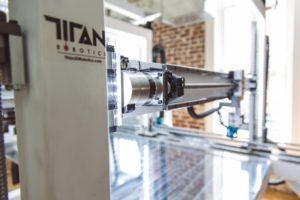 The build volume of the Cronus, while customizable to fit a customer’s needs, has a standard build volume of 72″ x 30″ x 20″, which rivals that of the Atlas, the company’s flagship industrial 3D printer and one of the largest FFF 3D printers out there. In contrast, the large-format Hyperion 3D printer only has a 24″ x 24″ x 24″ build volume. The Cronus comes with a fully heated enclosure, so users can safely print with higher temperature plastics like ABS. However, open air printing is possible for PLA and PETG materials.
The build volume of the Cronus, while customizable to fit a customer’s needs, has a standard build volume of 72″ x 30″ x 20″, which rivals that of the Atlas, the company’s flagship industrial 3D printer and one of the largest FFF 3D printers out there. In contrast, the large-format Hyperion 3D printer only has a 24″ x 24″ x 24″ build volume. The Cronus comes with a fully heated enclosure, so users can safely print with higher temperature plastics like ABS. However, open air printing is possible for PLA and PETG materials.
“Machines running collaborative multi-head 3D printing technology require a higher level of precision than is typical of large format deposition systems,” said Bastian. “This is why we’re excited to use the Cronus as an ongoing development platform.”
The Cronus will go on the market for commercial sale next month. Discuss in the Cronus forum at 3DPB.com.
Subscribe to Our Email Newsletter
Stay up-to-date on all the latest news from the 3D printing industry and receive information and offers from third party vendors.
You May Also Like
Gorilla Sports GE’s First 3D Printed Titanium Cast
How do you help a gorilla with a broken arm? Sounds like the start of a bad joke a zookeeper might tell, but it’s an actual dilemma recently faced by...
Nylon 3D Printed Parts Made More Functional with Coatings & Colors
Parts 3D printed from polyamide (PA, Nylon) 12 using powder bed fusion (PBF) are a mainstay in the additive manufacturing (AM) industry. While post-finishing processes have improved the porosity of...
$25M to Back Sintavia’s Largest Expansion of Metal 3D Printing Capacity Since 2019
Sintavia, the digital manufacturing company specializing in mission-critical parts for strategic sectors, announced a $25 million investment to increase its production capacity, the largest expansion to its operations since 2019....
Velo3D Initiates Public Offering in a Bid to Strengthen Financial Foundations and Drive Future Growth
Velo3D (NYSE: VLD) has been among a number of publicly traded 3D printing firms that have attempted to weather the current macroeconomic climate. After posting a challenging financial report for 2023,...


